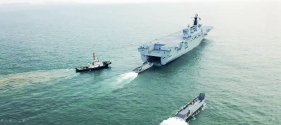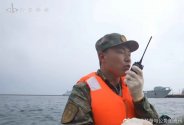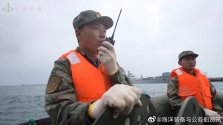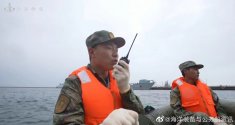054A: *cries in her "frigate VLS"*
You are using an out of date browser. It may not display this or other websites correctly.
You should upgrade or use an alternative browser.
You should upgrade or use an alternative browser.
PLA Navy news, pics and videos
- Thread starter Jeff Head
- Start date
Sounds like a smaller and slower version of Poseidon/Status-6. Small means can be launched from many platforms. Sound more appropriate for a UUV instead of a nuclear deterrent, to be honest. Also, it is SCMP so take it with a huge grain of salt.
A Beijing research team says it has completed the conceptual design for a small, low-cost nuclear reactor that would be able to drive a swarm of torpedoes across the Pacific Ocean in about a week.
The Chinese researchers are proposing a mini version of the Russian Poseidon unmanned submarine – the world’s first known underwater drone powered by nuclear energy.
Unlike the Poseidon, which cannot be mass-produced because it is too big, expensive and destructive, the mini version could be fitted into a standard torpedo tube and launched in large numbers from almost any submarine or warship, the scientists said.
My comment: Unless they are going to use equipment meant for RHIBs I don't see how surface warships going to launch this.
Each torpedo would use a disposable nuclear reactor to reach and maintain a cruising speed of over 30 knots (56km/h or 35mph) for 200 hours before dumping the reactor to the seabed and drawing power from a battery to launch an attack with conventional weapons.
My comment: The disposal of nuclear reactor is likely for avoiding wide-spread contamination and switch to conventional propulsion is likely for increasing the speed. Nuclear reactors have low power outputs for their sizes and weigths, afterall.
Lead scientist Guo Jian from the China Institute of Atomic Energy said there is a fundamental difference between the design and Poseidon, in a paper published this month by the peer-reviewed Journal of Unmanned Undersea Systems, a publication run by the China Shipbuilding Industry Corporation, the country’s biggest naval contractor.
“Thanks to its high flexibility and low cost, this unmanned underwater vehicle equipped with the nuclear power system can be used as a conventional force like an attack nuclear submarine, rather than as a nuclear missile,” he said.
According to Russian media reports, the Poseidon’s two-megaton nuclear warhead – 100 times more powerful than the Hiroshima bomb – could destroy a coastal city or wider area.
But the Chinese researchers said the use of such a weapon could trigger a world-ending nuclear war, making it unlikely that many more will be built. Instead, the Poseidon mainly serves as a strategic weapon, they said.
Guo said there is a growing demand in China for “small, high-speed, long-range unmanned underwater vehicles that can be used in reconnaissance, tracking, attack and strategic strike”.
My comment: The article may be credible since they mention authoritative sources. Contamination that is possible from this weapon may still escalate a war though. Maybe this is why they are thinking about a seperating reactor section.
Nuclear power can provide an enormous amount of energy to support these missions, but most reactors come with a sophisticated structure and high cost.
To build a new nuclear power system with “mature and simple technology that is easy to use and maintain, inexpensive and suitable for mass production, we need to think out of the box,” Guo said.
For their design the project team stripped most shielding materials from their reactor, protecting only some critical components from radiation. They also replaced expensive coatings made with rare earth elements inside the reactor core with cheap materials such as graphite.
To further cut costs, the scientists propose using some commercially available components on the international market instead of military-grade products.
The reactor, as heavy as two average Chinese adult males, would generate more than 1.4 megawatts of heat with less than 4kg (8.8lbs) of low-concentration uranium fuel.
According to Guo’s calculations, only about six per cent of the generated heat would be converted to electricity to propel the torpedo because of the low efficiency of the cheap components, but the energy would be more than enough for a one-way trip.
“When the manufacturing cost is low enough, even if the nuclear powered device can only be used once, the overall cost will be low. This in turn stimulates us to make the system simpler and smaller,” the researchers said.
Because the mini reactor would produce no radioactivity, service personnel could handle it as a “clean asset” without the need for protective gear, they said.
A chain reaction would start as soon as the torpedo left the launching platform and take about half an hour – 20 times faster than a typical reactor on a nuclear submarine – to reach a working temperature of 300 degrees Celsius (572 Fahrenheit) and accelerate the torpedo to a cruising speed of around 60km/h (37mph).
The researchers estimate the reactor would be able to operate for up to 400 hours, cruising over 10,000km (6,200 miles) – about the distance from Shanghai to San Francisco.
It would then separate from the torpedo and fall to the bottom of the deep sea, activating a safety mechanism to kill the remaining chain reaction, they said.
My comment: It seems there were translation errors. Some sentences feel weird. It seems the reactor is designed for being critical only during the cruise. 4 kg of lowly-enriched non-reacting Uranium is really of low danger level. Good for practicality, environment and avoiding escelation.
“Even if the hull is broken, the interior is filled with water, and the whole body falls into the wet sand on the seabed, the reactor will not have a critical accident. The safety is ensured.”
Ma Liang, a researcher studying submarine launch technology with the Navy Submarine Academy in Qingdao, Shandong province, said “smart torpedoes” acting in packs would play an important role in future sea battles.
AI technology such as machine learning would enable the torpedoes to select and attack targets with little or no human intervention, she said in a separate paper published in the same journal on July 13.
Smart torpedoes would be able to set up an ambush on the other side of the ocean and “strike submarines as they leave a port in home waters that is difficult to reach by manned platforms”, Ma said.
The torpedo swarm could take orders from humans or a command unmanned underwater vehicle to carry out a wide range of missions such as reconnaissance and following a high value target, she said. “This is the most dynamic research technology field at present.”
My comment: Torpedoes will likely become more UUV-like in future. Torpedoes that can cooperate with other torpedoes, larger UUVs, and smaller torpedo launched UUVs (So a USV can launch a large UUV which can launch a smart torpedo that can launch smaller UUVs. Yes, sounds like droneception) are active research topics. It is nice to see China is looking at the concept too.
A Beijing research team says it has completed the conceptual design for a small, low-cost nuclear reactor that would be able to drive a swarm of torpedoes across the Pacific Ocean in about a week.
The Chinese researchers are proposing a mini version of the Russian Poseidon unmanned submarine – the world’s first known underwater drone powered by nuclear energy.
Unlike the Poseidon, which cannot be mass-produced because it is too big, expensive and destructive, the mini version could be fitted into a standard torpedo tube and launched in large numbers from almost any submarine or warship, the scientists said.
My comment: Unless they are going to use equipment meant for RHIBs I don't see how surface warships going to launch this.
Each torpedo would use a disposable nuclear reactor to reach and maintain a cruising speed of over 30 knots (56km/h or 35mph) for 200 hours before dumping the reactor to the seabed and drawing power from a battery to launch an attack with conventional weapons.
My comment: The disposal of nuclear reactor is likely for avoiding wide-spread contamination and switch to conventional propulsion is likely for increasing the speed. Nuclear reactors have low power outputs for their sizes and weigths, afterall.
Lead scientist Guo Jian from the China Institute of Atomic Energy said there is a fundamental difference between the design and Poseidon, in a paper published this month by the peer-reviewed Journal of Unmanned Undersea Systems, a publication run by the China Shipbuilding Industry Corporation, the country’s biggest naval contractor.
“Thanks to its high flexibility and low cost, this unmanned underwater vehicle equipped with the nuclear power system can be used as a conventional force like an attack nuclear submarine, rather than as a nuclear missile,” he said.
According to Russian media reports, the Poseidon’s two-megaton nuclear warhead – 100 times more powerful than the Hiroshima bomb – could destroy a coastal city or wider area.
But the Chinese researchers said the use of such a weapon could trigger a world-ending nuclear war, making it unlikely that many more will be built. Instead, the Poseidon mainly serves as a strategic weapon, they said.
Guo said there is a growing demand in China for “small, high-speed, long-range unmanned underwater vehicles that can be used in reconnaissance, tracking, attack and strategic strike”.
My comment: The article may be credible since they mention authoritative sources. Contamination that is possible from this weapon may still escalate a war though. Maybe this is why they are thinking about a seperating reactor section.
Nuclear power can provide an enormous amount of energy to support these missions, but most reactors come with a sophisticated structure and high cost.
To build a new nuclear power system with “mature and simple technology that is easy to use and maintain, inexpensive and suitable for mass production, we need to think out of the box,” Guo said.
For their design the project team stripped most shielding materials from their reactor, protecting only some critical components from radiation. They also replaced expensive coatings made with rare earth elements inside the reactor core with cheap materials such as graphite.
To further cut costs, the scientists propose using some commercially available components on the international market instead of military-grade products.
The reactor, as heavy as two average Chinese adult males, would generate more than 1.4 megawatts of heat with less than 4kg (8.8lbs) of low-concentration uranium fuel.
According to Guo’s calculations, only about six per cent of the generated heat would be converted to electricity to propel the torpedo because of the low efficiency of the cheap components, but the energy would be more than enough for a one-way trip.
“When the manufacturing cost is low enough, even if the nuclear powered device can only be used once, the overall cost will be low. This in turn stimulates us to make the system simpler and smaller,” the researchers said.
Because the mini reactor would produce no radioactivity, service personnel could handle it as a “clean asset” without the need for protective gear, they said.
A chain reaction would start as soon as the torpedo left the launching platform and take about half an hour – 20 times faster than a typical reactor on a nuclear submarine – to reach a working temperature of 300 degrees Celsius (572 Fahrenheit) and accelerate the torpedo to a cruising speed of around 60km/h (37mph).
The researchers estimate the reactor would be able to operate for up to 400 hours, cruising over 10,000km (6,200 miles) – about the distance from Shanghai to San Francisco.
It would then separate from the torpedo and fall to the bottom of the deep sea, activating a safety mechanism to kill the remaining chain reaction, they said.
My comment: It seems there were translation errors. Some sentences feel weird. It seems the reactor is designed for being critical only during the cruise. 4 kg of lowly-enriched non-reacting Uranium is really of low danger level. Good for practicality, environment and avoiding escelation.
“Even if the hull is broken, the interior is filled with water, and the whole body falls into the wet sand on the seabed, the reactor will not have a critical accident. The safety is ensured.”
Ma Liang, a researcher studying submarine launch technology with the Navy Submarine Academy in Qingdao, Shandong province, said “smart torpedoes” acting in packs would play an important role in future sea battles.
AI technology such as machine learning would enable the torpedoes to select and attack targets with little or no human intervention, she said in a separate paper published in the same journal on July 13.
Smart torpedoes would be able to set up an ambush on the other side of the ocean and “strike submarines as they leave a port in home waters that is difficult to reach by manned platforms”, Ma said.
The torpedo swarm could take orders from humans or a command unmanned underwater vehicle to carry out a wide range of missions such as reconnaissance and following a high value target, she said. “This is the most dynamic research technology field at present.”
My comment: Torpedoes will likely become more UUV-like in future. Torpedoes that can cooperate with other torpedoes, larger UUVs, and smaller torpedo launched UUVs (So a USV can launch a large UUV which can launch a smart torpedo that can launch smaller UUVs. Yes, sounds like droneception) are active research topics. It is nice to see China is looking at the concept too.
This is designed for existing submarines to launch, not Surface Warships or UUVs, it’s breakthrough is just as much in the safe handling of what is basically an unshielded reactor as it is for the reactor itself and the special tactics it allows.Sounds like a smaller and slower version of Poseidon/Status-6. Small means can be launched from many platforms. Sound more appropriate for a UUV instead of a nuclear deterrent, to be honest. Also, it is SCMP so take it with a huge grain of salt.
A Beijing research team says it has completed the conceptual design for a small, low-cost nuclear reactor that would be able to drive a swarm of torpedoes across the Pacific Ocean in about a week.
The Chinese researchers are proposing a mini version of the Russian Poseidon unmanned submarine – the world’s first known underwater drone powered by nuclear energy.
Unlike the Poseidon, which cannot be mass-produced because it is too big, expensive and destructive, the mini version could be fitted into a standard torpedo tube and launched in large numbers from almost any submarine or warship, the scientists said.
My comment: Unless they are going to use equipment meant for RHIBs I don't see how surface warships going to launch this.
Each torpedo would use a disposable nuclear reactor to reach and maintain a cruising speed of over 30 knots (56km/h or 35mph) for 200 hours before dumping the reactor to the seabed and drawing power from a battery to launch an attack with conventional weapons.
My comment: The disposal of nuclear reactor is likely for avoiding wide-spread contamination and switch to conventional propulsion is likely for increasing the speed. Nuclear reactors have low power outputs for their sizes and weigths, afterall.
Lead scientist Guo Jian from the China Institute of Atomic Energy said there is a fundamental difference between the design and Poseidon, in a paper published this month by the peer-reviewed Journal of Unmanned Undersea Systems, a publication run by the China Shipbuilding Industry Corporation, the country’s biggest naval contractor.
“Thanks to its high flexibility and low cost, this unmanned underwater vehicle equipped with the nuclear power system can be used as a conventional force like an attack nuclear submarine, rather than as a nuclear missile,” he said.
According to Russian media reports, the Poseidon’s two-megaton nuclear warhead – 100 times more powerful than the Hiroshima bomb – could destroy a coastal city or wider area.
But the Chinese researchers said the use of such a weapon could trigger a world-ending nuclear war, making it unlikely that many more will be built. Instead, the Poseidon mainly serves as a strategic weapon, they said.
Guo said there is a growing demand in China for “small, high-speed, long-range unmanned underwater vehicles that can be used in reconnaissance, tracking, attack and strategic strike”.
My comment: The article may be credible since they mention authoritative sources. Contamination that is possible from this weapon may still escalate a war though. Maybe this is why they are thinking about a seperating reactor section.
Nuclear power can provide an enormous amount of energy to support these missions, but most reactors come with a sophisticated structure and high cost.
To build a new nuclear power system with “mature and simple technology that is easy to use and maintain, inexpensive and suitable for mass production, we need to think out of the box,” Guo said.
For their design the project team stripped most shielding materials from their reactor, protecting only some critical components from radiation. They also replaced expensive coatings made with rare earth elements inside the reactor core with cheap materials such as graphite.
To further cut costs, the scientists propose using some commercially available components on the international market instead of military-grade products.
The reactor, as heavy as two average Chinese adult males, would generate more than 1.4 megawatts of heat with less than 4kg (8.8lbs) of low-concentration uranium fuel.
According to Guo’s calculations, only about six per cent of the generated heat would be converted to electricity to propel the torpedo because of the low efficiency of the cheap components, but the energy would be more than enough for a one-way trip.
“When the manufacturing cost is low enough, even if the nuclear powered device can only be used once, the overall cost will be low. This in turn stimulates us to make the system simpler and smaller,” the researchers said.
Because the mini reactor would produce no radioactivity, service personnel could handle it as a “clean asset” without the need for protective gear, they said.
A chain reaction would start as soon as the torpedo left the launching platform and take about half an hour – 20 times faster than a typical reactor on a nuclear submarine – to reach a working temperature of 300 degrees Celsius (572 Fahrenheit) and accelerate the torpedo to a cruising speed of around 60km/h (37mph).
The researchers estimate the reactor would be able to operate for up to 400 hours, cruising over 10,000km (6,200 miles) – about the distance from Shanghai to San Francisco.
It would then separate from the torpedo and fall to the bottom of the deep sea, activating a safety mechanism to kill the remaining chain reaction, they said.
My comment: It seems there were translation errors. Some sentences feel weird. It seems the reactor is designed for being critical only during the cruise. 4 kg of lowly-enriched non-reacting Uranium is really of low danger level. Good for practicality, environment and avoiding escelation.
“Even if the hull is broken, the interior is filled with water, and the whole body falls into the wet sand on the seabed, the reactor will not have a critical accident. The safety is ensured.”
Ma Liang, a researcher studying submarine launch technology with the Navy Submarine Academy in Qingdao, Shandong province, said “smart torpedoes” acting in packs would play an important role in future sea battles.
AI technology such as machine learning would enable the torpedoes to select and attack targets with little or no human intervention, she said in a separate paper published in the same journal on July 13.
Smart torpedoes would be able to set up an ambush on the other side of the ocean and “strike submarines as they leave a port in home waters that is difficult to reach by manned platforms”, Ma said.
The torpedo swarm could take orders from humans or a command unmanned underwater vehicle to carry out a wide range of missions such as reconnaissance and following a high value target, she said. “This is the most dynamic research technology field at present.”
My comment: Torpedoes will likely become more UUV-like in future. Torpedoes that can cooperate with other torpedoes, larger UUVs, and smaller torpedo launched UUVs (So a USV can launch a large UUV which can launch a smart torpedo that can launch smaller UUVs. Yes, sounds like droneception) are active research topics. It is nice to see China is looking at the concept too.
This means torpedo room staff can safely load these up into the very many existing tubes they have and have no issues.
If we are hearing about this in the SCMP, I think it means it’s already deployed
Got to admit it's been 30 years since I sat through a very dry lecture on critical mass but this doesn't sound particularly plausible. I dont think it would be possible to get a mere 4kg of low grade uranium critical .The reactor, as heavy as two average Chinese adult males, would generate more than 1.4 megawatts of heat with less than 4kg (8.8lbs) of low-concentration uranium fuel.
Uranium unless in a critical mass slowly decays producing very little heat.
Critical mass is achieved when the neutron density is high enough to sustain continuous nuclear reactions, (bombs are super critical in which the nuetron density rises exponentially) . 235 decays randomly over time or when hit by a neutron (a by product of decay)
A Sphere of pure 235 reaches critical at several tens of kilos. Critical mass is proportional to the inverse square of the density of the fissionable material in this case 235. Low grade Uranium is only a few percent 235.
Nuetron reflectors can reduce the critical mass but getting 5% 235 to reach critical in a 4kg mass of uranium 235/238 doesn't sound plausible .
This is only true for bare mass. The use of regulators like water changes everything by making neutron absorption much likelier. Especially heavy water is very effective. Heavy water can get even natural uranium critical. China has actual full-size heavy water reactors. It is a quite cheap material for China.Got to admit it's been 30 years since I sat through a very dry lecture on critical mass but this doesn't sound particularly plausible. I dont think it would be possible to get a mere 4kg of low grade uranium critical .
Uranium unless in a critical mass slowly decays producing very little heat.
Critical mass is achieved when the neutron density is high enough to sustain continuous nuclear reactions, (bombs are super critical in which the nuetron density rises exponentially) . 235 decays randomly over time or when hit by a neutron (a by product of decay)
A Sphere of pure 235 reaches critical at several tens of kilos. Critical mass is proportional to the inverse square of the density of the fissionable material in this case 235. Low grade Uranium is only a few percent 235.
Nuetron reflectors can reduce the critical mass but getting 5% 235 to reach critical in a 4kg mass of uranium 235/238 doesn't sound plausible .
The difference in capabilities and expected goals for the nuclear-powered ULR torpedo by China versus Poseidon by Russia tells me something...
Russia is seeking asymmetrical parity with the US + NATO.
China is seeking symmetrical parity with the US + allies in the Pacific.
Russia is seeking asymmetrical parity with the US + NATO.
China is seeking symmetrical parity with the US + allies in the Pacific.
Last edited:
Nice video of the PLAN’s newest landing craft under way on what can be assumed to be sea trials of some sort.
Is this ship meant to be deployable from type 072/075 amphibious assault ships ?Nice video of the PLAN’s newest landing craft under way on what can be assumed to be sea trials of some sort.
Is this ship meant to be deployable from type 072/075 amphibious assault ships ?
Utility landing craft are often designed to be embarked onto larger expeditionary ships; I can’t speak on the [Type 072A] currently however I don’t believe that the [Type 072A] has provisions to embark any landing craft as its main purpose is to embark and deploy amphibious assault vehicles and other armored combat vehicles.
It has already been shown to have been embarked on the [Type 075] on at-least one occasion for training.
I would also imagine that the [Type 071] will also utilize the newer utility landing craft interchangeably with LCACs as with the [Type 075] in support of whatever mission the ship(s) would be trying to accomplish.
Attachments
PLAN [Type 072III] test ship equipped with an experimental rail-gun system has been spotted in a recent training video.





